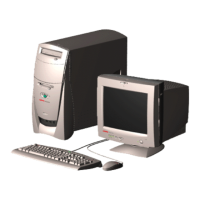and a grounded floor mat.
Static-Shielding Protection Levels
Method
Antistatic Plastic Carbon-Loaded
Plastic
Metallized Laminate
Voltages
1,500 7,500 15,000
Grounding Workstations
To prevent static damage at the workstation, use the following precautions:
Cover the workstation with approved static-dissipative material. Provide a wrist
strap connected to the work surface and make sure all properly tools and
equipment are properly grounded.
■
Use static-dissipative mats, heel straps, or air ionizers to give added protection.■
Handle electrostatic-sensitive components, parts, and assemblies by the case or
PCB laminate. Handle them only at static-free workstations.
■
Avoid contact with pins, leads, or circuitry.■
Turn off power and input signals before inserting and removing connectors or
test equipment.
■
Use fixtures made of static-safe materials when fixtures must directly contact
dissipative surfaces.
■
Keep the work area free of nonconductive materials such as ordinary plastic
assembly aids and Styrofoam.
■
Use field service tools, such as cutters, screwdrivers, and vacuums, that are
conductive.
■
Use a portable field service kit with a static dissipative vinyl pouch that folds
out of a work mat. Also use a wrist strap and a ground cord for the work
surface. Ground the cord to the chassis of the equipment undergoing test or
repair.
■
Grounding Equipment
Use the following equipment to prevent static electricity damage to the equipment:
Wrist Straps are flexible straps with a minimum of 1 megohm ±10% resistance to the ground
cords. To provide proper ground, a strap must be worn snug against the skin. On grounded mats
without banana-plug connectors, connect a wrist strap with alligator clips.
Heelstraps/Toestraps/Bootstraps can be used at standing workstations and are compatible with
most types of boots and shoes. On conductive floors or dissipative floor mats, use them on both
http://www.compaq.com/athome/support/msgs/7400/electro.html (3 of 4) [1/8/2002 3:52:34 PM]

